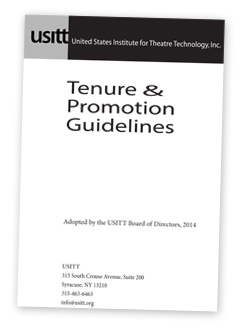News & Notices
Share Revised Tenure, Promotion Guidelines
 USITT recently released the latest revision of its ground-breaking Tenure and Promotion Guidelines for evaluating college theatre production faculty. The revision process took three years, involved multiple contributors, and produced a document that anyone can access for free.
USITT recently released the latest revision of its ground-breaking Tenure and Promotion Guidelines for evaluating college theatre production faculty. The revision process took three years, involved multiple contributors, and produced a document that anyone can access for free.
The guidelines originated in 1987 to address the long-standing problem of how to evaluate the many theatre production personnel being hired for college teaching positions. The goal was and remains to provide a resource to assist in evaluating the work of faculty whose primary research and creative activity outlet is performance.
USITT last revised the guidelines in 2000. The 2014 version adds projection design as an emerging discipline and includes greater use of computer technology among the necessary tools for success for technical directors and designers.
The guidelines continue to affirm that the most appropriate terminal degree for production faculty is a master of fine arts. USITT also recommends that "all off-campus design and production work be considered the equivalent of juried, refereed publication," and that faculty involved in "the creation of new works" are obliged to disseminate them through public performance.
The guidelines include appendices addressing the roles of costume designers and technicians, projection and media designers, scenic designers, stage and production managers, technical directors, sound designers, and lighting designers.
The Board of Directors approved the revised guidelines this fall and offers the document free to all who wish to put it to use to establish clear performance standards by which colleagues and administrators can evaluate production faculty.
The Institute will share the revised guidelines with several affiliate organizations including the Association for Theatre in Higher Education, National Association of Schools of Theatre, the Council of Colleges of Arts and Sciences, the Committee on Institutional Cooperation, and the International Council of Fine Arts Deans.
The guidelines can
- Be added as an appendix to college or university P&T documentation to provide criteria and expectations for academic production personnel,
- Help academic leaders understand the nature of production faculty job descriptions, especially combined jobs like lighting designer/sound designer,
- Stand as a recognized industry standard in annual as well as promotion reviews, and
- Suggest strategies to promotion candidates for documenting their work and preparing portfolio materials for external reviewers.
Many academic institutions already use the USITT guidelines as their standard. The Institute will continue to update and share them as part of its mission to promote performing arts design and technology education.

